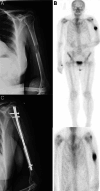Practical management of renal cell carcinoma: integrating current approaches with advances in bone metastasis treatment
- PMID: 38828980
- PMCID: PMC11195343
- DOI: 10.1530/EOR-23-0178
Practical management of renal cell carcinoma: integrating current approaches with advances in bone metastasis treatment
Abstract
Renal cell carcinoma (RCC) is a common type of tumor that can develop in the kidney. It is responsible for around one-third of all cases of neoplasms. RCC manifests itself in a variety of distinct subtypes. The most frequent of which is clear cell RCC, followed by papillary and chromophobe RCC. RCC has the potential for metastasis to a variety of organs; nevertheless, bone metastases are one of the most common and potentially fatal complications. These bone metastases are characterized by osteolytic lesions that can result in pathological fractures, hypercalcemia, and other complications, which can ultimately lead to a deterioration in quality of life and an increase morbidity. While nephrectomy remains a foundational treatment for RCC, emerging evidence suggests that targeted therapies, including tyrosine kinase inhibitors and T cell checkpoint inhibitors, may offer effective alternatives, potentially obviating the need for adjuvant nephrectomy in certain cases of metastatic RCC Bone metastases continue to be a difficult complication of RCC, which is why more research is required to enhance patient outcome.
Keywords: bone metastases; fatal complications; renal cell carcinoma.
Conflict of interest statement
The authors declare that there is no conflict of interest that could be perceived as prejudicing the impartiality of the work reported here.
Figures






Similar articles
-
Effect of papillary and chromophobe cell type on disease-free survival after nephrectomy for renal cell carcinoma.Ann Surg Oncol. 2004 Jan;11(1):71-7. doi: 10.1007/BF02524349. Ann Surg Oncol. 2004. PMID: 14699037
-
The Metastasis Pattern of Renal Cell Carcinoma Is Influenced by Histologic Subtype, Grade, and Sarcomatoid Differentiation.Medicina (Kaunas). 2023 Oct 17;59(10):1845. doi: 10.3390/medicina59101845. Medicina (Kaunas). 2023. PMID: 37893563 Free PMC article.
-
[Chromophobe renal cell carcinoma: a clinicopathological study of 16 cases].Hinyokika Kiyo. 2006 Jan;52(1):1-6. Hinyokika Kiyo. 2006. PMID: 16479980 Japanese.
-
Metastases from renal cell carcinoma-Report of three unpredictable cases and literature review.Indian J Cancer. 2021 Apr-Jun;58(2):273-277. doi: 10.4103/ijc.IJC_160_20. Indian J Cancer. 2021. PMID: 34100413 Review.
-
[Two Cases of Metastatic and Recurrent Non-Clear Cell Renal Cell Carcinoma Re-Diagnosed as Renal Mucinous Tubular and Spindle Cell Carcinoma during Long-Term Follow-Up].Hinyokika Kiyo. 2018 Mar;64(3):111-115. doi: 10.14989/ActaUrolJap_64_3_111. Hinyokika Kiyo. 2018. PMID: 29684960 Review. Japanese.
Cited by
-
Revealing the Mechanism of Esculin in Treating Renal Cell Carcinoma Based on Network Pharmacology and Experimental Validation.Biomolecules. 2024 Aug 22;14(8):1043. doi: 10.3390/biom14081043. Biomolecules. 2024. PMID: 39199428 Free PMC article.
References
-
- Petard JJ, Leray E, Rioux-Leclercq N, Cindolo L, Ficarra V, Zisman A, De La Taille A, Tostain J, Artibani W, Abbou CC, et al.Prognostic value of histologic subtypes in renal cell carcinoma: a multicenter experience. Journal of Clinical Oncology 2005232763–2771. (10.1200/JCO.2005.07.055) - DOI - PubMed
-
- Cancer Genome Atlas Research Network, Linehan WM, Spellman PT, Ricketts CJ, Creighton CJ, Fei SS, Davis C, Wheeler DA, Murray BA, Schmidt L, et al.Comprehensive molecular characterization of papillary renal-cell carcinoma. New England Journal of Medicine 2016374135–145. (10.1056/NEJMoa1505917) - DOI - PMC - PubMed
Publication types
LinkOut - more resources
Full Text Sources

